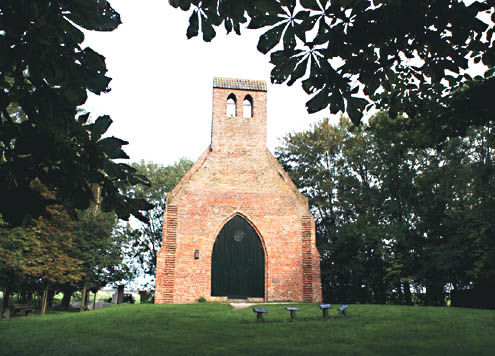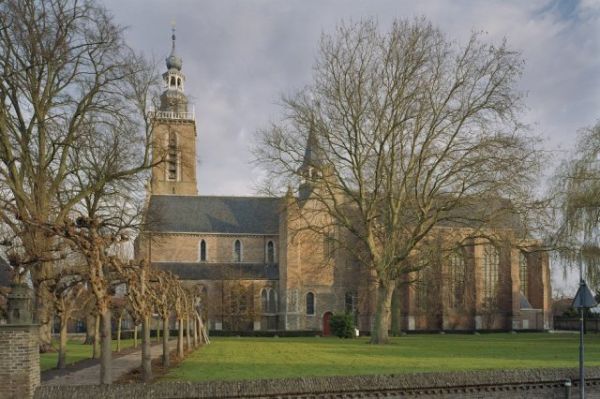Religious past
Churches and monasteries are iconic buildings in a city or village. How people practised their religion in the past and how important it was in their lives can also be seen in artifacts in museum collections and in the continued existence of rituals.
Early Christianity
Altars dedicated to the gods, such as those erected for Nehalennia, bear silent witnesses to the religious life of people in Roman times. Christianity made its way to what is now Zeeland during the seventh century. Eligius, bishop of Noyon and Doornik, was the first to spread Christianity in these parts. It was only in the surroundings of Aardenburg that his ideas managed to hold sway.
Beyond the Westerschelde, English missionaries had the greatest influence. One of them was the legendary Willibrord, who came to Walcheren in the year 690 to preach Christianity there. Within fifty years, he was able to christen a large part of the Dutch coastal regions and founded the Echternach abbey (Luxembourg). All kinds of miraculous stories circulated about him. For example, he is rumoured to have drawn a cross in the earth near Zoutelande to create a source of fresh water. The Willibrordus well in the village is a reminder of this. Churches in Westkapelle and Oostkapelle were dedicated to Willibrord. Westkapelle grew to be the centre of Willibrord worship and a famous place of pilgrimage. The church housed relics of the missionary, presumably donated by the Echternach abbey where Willibrord died.

Tomb of St Willibrord in Echternach (photo by Paul Hermans).
Churches and monasteries
Christianity likely lost its influence during the Viking era, but after that the church consolidated its hold. In the thirteenth century, almost every village in Zeeland had its own church. Many of the villages from that time were also named after their church. Apart from chapels and churches, monasteries were also built throughout the province. The monastic communities were part of monastic orders that spanned across parts of Europe.
A proportion of the churches and monasteries in Zeeland were lost during the Middle Ages. Some villages – and with them the church community – were so small that they proved unviable. Furthermore, the Iconoclastic Fury of 1566 wreaked havoc. But what was really devastating were the early years of the Eighty Years’ War. In the struggle, which was largely fought in the countryside, a great many religious buildings were destroyed. Not all of them were rebuilt, due to a lack of money.

The vestiges of the medieval church in Hoogelande survived the centuries and were rebuilt as a chapel in 1964-1965.
More religious denominations
At the end of the sixteenth century, the Reformation gained a foothold in large parts of Zeeland. The humanist ideology had already spread to Zeeland from elsewhere in Europe earlier in the century and was subsequently followed by the ideas of Luther and Calvin. The new Protestant congregations took over the old Catholic church buildings. Other religious denominations, especially Jews and Catholics, were not allowed to practice their faith in public.

Sint-Baafskerk (Imagebank RCE, photo by C.S. Booms).
Zeeland was a place of refuge for people from Europe who had to flee for religious reasons on several occasions: Southern Dutch citizens at the end of the sixteenth century, Huguenots from France from the seventeenth century onwards and Salzburgers in the eighteenth century. Also thanks to the numerous trade connections the cities had, people of faith from all corners of the world settled here.
At the end of the eighteenth century, all religions were granted political equality in the Netherlands. From that moment on, the other religious denominations could also come out into the open. Catholics built new churches. In the Protestant churches, new denominations split off from each other. This also became visible in the streetscape. Consequently, not only in the cities but also in many villages, there was more than one church building. As a result of secularisation, a process that took hold in the previous century, these buildings have now lost their original function and new forms of use are now being sought.

Silver lidded goblet of the St James’ guild in Sint-Maartensdijk (Zeeuws Museum, KZGW collection). The cup commemorates a pilgrimage to Santiago de Compostela in 1595.
Travelers
Influences stemmed not only from people who visited Zeeland, but also from the journeys that Zeelanders themselves made for religious reasons. Many thousands of pilgrims’ insignias have been unearthed in Zeeland. Accounts of pilgrimages, such as the diary kept by the nobleman and knight Mher Joos van Ghistele from Zuiddorpe of his journey to the Holy Land between 1481 and 1485, also bear witness to this. Precious memorabilia also testify to the fact that people went on long journeys. A particularly fine example of this is the silver lidded goblet of the Sint-Jacobsgilde from Sint-Maartensdijk, which the guild had made on the occasion of a pilgrimage by guild members to Santiago de Compostella in the year 1595.
